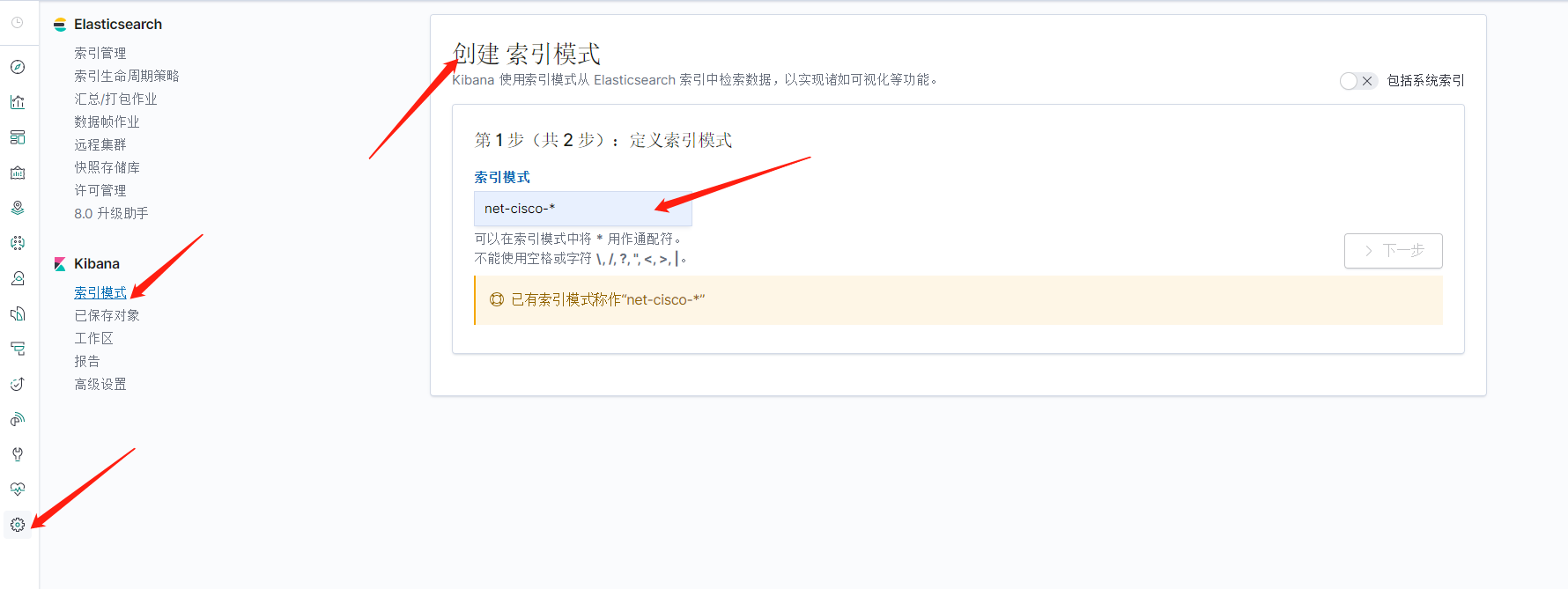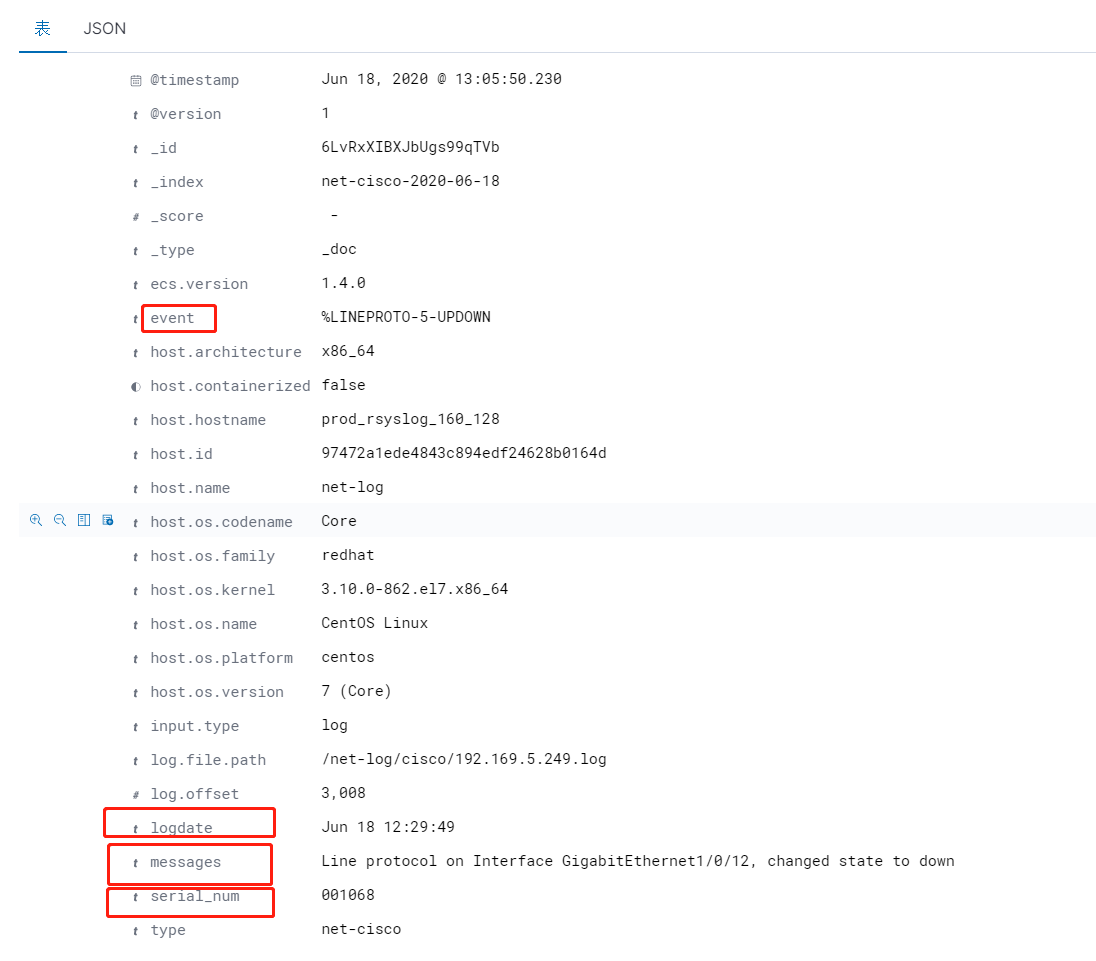rsyslog+ELK收集Cisco日志
一、配置rsyslog服务收集Cisco日志
1.安装配置rsyslog收集cisco日志
[root@prod_rsyslog_160_128 ~]# yum install -y rsyslog #安装rsyslog服务 [root@prod_rsyslog_160_128 ~]# egrep -v "^$|#" /etc/rsyslog.conf $ModLoad imudp # imupd是模块名,支持udp协议 $UDPServerRun 514 #允许514端口接收使用UDP协议转发过来的日志 $ModLoad imtcp # imtcp是模块名,支持tcp协议 $InputTCPServerRun 514 # 允许514端口接收使用TCP协议转发过来的日志 $WorkDirectory /var/lib/rsyslog $ActionFileDefaultTemplate RSYSLOG_TraditionalFileFormat #使用默认日志模板 $IncludeConfig /etc/rsyslog.d/*.conf $OmitLocalLogging on $IMJournalStateFile imjournal.state *.info;mail.none;authpriv.none;cron.none /var/log/messages authpriv.* /var/log/secure mail.* -/var/log/maillog cron.* /var/log/cron *.emerg :omusrmsg:* uucp,news.crit /var/log/spooler local7.* /var/log/boot.log $template myformat,"%FROMHOST-IP%: %msg:2:$%\n" #定义日志模板,只记录日志信息不添加时间戳并删除日志开头空格并且将IP地址写入开头 $template cisco,"/net-log/cisco/%FROMHOST-IP%.log" #定义日志文件模板,Cisco为模板名称,以来源IP作为文件名 local4.* ?cisco;myformat #定义级别为4的日志使用cisco myformat模板 [root@prod_rsyslog_160_128 ~]# systemctl restart rsyslog.service #重启服务
2.配置Cisco设备
略,我们网络工程师配置的
3.测试
[root@prod_rsyslog_160_128 ~]# tree /net-log/ #日志文件正常创建
/net-log/
└── cisco
└── 192.169.5.249.log
1 directory, 1 file
[root@prod_rsyslog_160_128 ~]# tail -1 /net-log/cisco/192.169.5.249.log
001068: Jun 18 12:29:49: %LINEPROTO-5-UPDOWN: Line protocol on Interface GigabitEthernet1/0/12, changed state to down #日志格式如下
二、配置filebeat收集Cisco日志
1.修改filebeat配置文件
[root@prod_rsyslog_160_128 filebeat]# egrep -v "^$|#" filebeat.yml
filebeat.inputs:
- type: log
enabled: true
fields_under_root: true #新增fields成为顶级目录,而不是将其放在fields目录下
paths:
- /net-log/cisco/*.log #日志路径
fields:
type: net-cisco #输出给kafka时作为topic使用
filebeat.config.modules:
path: ${path.config}/modules.d/*.yml
reload.enabled: false
setup.template.settings:
index.number_of_shards: 1
name: net-log #主机名称
processors:
- add_host_metadata: ~
- drop_fields: #删除一些不需要字段
fields: ["sort","beat","input_type","offset","source","agent"]
output.kafka: #kafka集群信息
enabled: true
hosts: ["172.16.160.121:9092","172.16.160.123:9092","172.16.160.123:9092"]
topic: '%{[type]}' #如果 fields_under_root为false则需要修改为fields.type
2.配置filebeat为系统服务
[root@prod_rsyslog_160_128 filebeat]# cat /etc/systemd/system/filebeat.service #注意替换文件中filebeat的路径
[Unit]
Description=filebeat server daemon
Documentation=/usrl/local/filebeat/filebeat -help
Wants=network-online.target
After=network-online.target
[Service]
User=root
Group=root
ExecStart=/usr/local/filebeat/filebeat -c /usr/local/filebeat/filebeat.yml --path.logs /usr/local/filebeat/logs #不要添加-e,会使 --path.logs失效
Restart=always [Install] WantedBy=multi-user.target
启动filebeat服务
[root@prod_rsyslog_160_128 filebeat]# systemctl restart filebeat.service
3.测试日志是否可以正常输出到kafka集群
1.查看topic是否正常创建
[root@prod_zk-kafka_160_121 ~]# /usr/local/kafka/bin/kafka-topics.sh --list --zookeeper 172.16.160.121:2181
__consumer_offsets
net-cisco
2.查看topic是否可以正常消费
[root@prod_zk-kafka_160_121 ~]# /usr/local/kafka/bin/kafka-console-consumer.sh --bootstrap-server 172.16.160.121:9092 --topic net-cisco --from-beginning
三、配置logstash
[root@prod_logstash_160_124 config]# cat net-cisco.conf input{ kafka { bootstrap_servers => "172.16.160.121:9092,172.16.160.123:9092,172.16.160.123:9092" consumer_threads => 5 topics => "net-cisco" group_id => "net-log" decorate_events => true type => "net-cisco" codec => "json" } } filter{ mutate { split => ["message",": "] #使用": "对日志内容进行切割 add_field => { "remote_ip" => "%{[message][0]}" "serial_num" => "%{[message][1]}" "logdate" => "%{[message][2]}" "event" => "%{[message][3]}" "messages" => "%{[message][4]}" } } mutate { remove_field => ["message"] #日志切割后删除 } date { match => ["timestamp", "dd/MMM/yyyy:HH:mm:ss Z"] timezone => "Asia/Shanghai" } } output { # stdout { codec => rubydebug } #调试时使用 if [type] == "net-cisco" { elasticsearch { hosts => ["172.16.160.125:9200","172.16.160.126:9200","172.16.160.127:9200"] index => "net-cisco-%{+YYYY-MM-dd}" #ES中索引名称,按天创建 } } }
启动服务
[root@prod_logstash_160_124 config]# ../bin/logstash -f cisco_log.conf -t --verbose
[root@prod_logstash_160_124 config]# nohup /usr/local/logstash-7.6.2/bin/logstash -f cisco_log.conf &> /tmp/logstch.log &
四、kibana创建索引模式并展示

浏览日志

查看日志字段

五、注意事项
1.filebeat删除字段时timestamp和type字段无法被删除
2.手动修改日志文件测试时请使用echo命令而不是vim,否则会导致日志被从头开始消费。这是因为filebeat跟踪inode更改以了解是否需要读取文件。使用vim编辑时,每次保存文件时,inode都会更改。使用 ls -li filename查看文件iNode号
3.filebeat -e和--path.logs无法同时生效
4.kafka如果禁止自动创建topic,每次新日志topic需要提前手动创建
5.kibana创建索引模式后刷新消失,可以尝试重启kibana服务
6.filebeat服务建议使用Supervisor或者systemctl管理,使用nohup启动服务可能会自动停止,社区中也有人存在同样问题,目前未找到具体原因
附rsyslog、logstash配置文件

# rsyslog configuration file # For more information see /usr/share/doc/rsyslog-*/rsyslog_conf.html # If you experience problems, see http://www.rsyslog.com/doc/troubleshoot.html #### MODULES #### # The imjournal module bellow is now used as a message source instead of imuxsock. $ModLoad imuxsock # provides support for local system logging (e.g. via logger command) $ModLoad imjournal # provides access to the systemd journal #$ModLoad imklog # reads kernel messages (the same are read from journald) #$ModLoad immark # provides --MARK-- message capability # Provides UDP syslog reception $ModLoad imudp $UDPServerRun 514 # Provides TCP syslog reception $ModLoad imtcp $InputTCPServerRun 514 #### GLOBAL DIRECTIVES #### # Where to place auxiliary files $WorkDirectory /var/lib/rsyslog # Use default timestamp format $ActionFileDefaultTemplate RSYSLOG_TraditionalFileFormat # File syncing capability is disabled by default. This feature is usually not required, # not useful and an extreme performance hit #$ActionFileEnableSync on # Include all config files in /etc/rsyslog.d/ $IncludeConfig /etc/rsyslog.d/*.conf # Turn off message reception via local log socket; # local messages are retrieved through imjournal now. $OmitLocalLogging on # File to store the position in the journal $IMJournalStateFile imjournal.state #### RULES #### # Log all kernel messages to the console. # Logging much else clutters up the screen. #kern.* /dev/console # Log anything (except mail) of level info or higher. # Don't log private authentication messages! *.info;mail.none;authpriv.none;cron.none /var/log/messages # The authpriv file has restricted access. authpriv.* /var/log/secure # Log all the mail messages in one place. mail.* -/var/log/maillog # Log cron stuff cron.* /var/log/cron # Everybody gets emergency messages *.emerg :omusrmsg:* # Save news errors of level crit and higher in a special file. uucp,news.crit /var/log/spooler # Save boot messages also to boot.log local7.* /var/log/boot.log #$template myformat,"%$NOW% %TIMESTAMP:8:15% %hostname% %syslogtag% %msg%\n" #$template myformat,"%msg:2:$%\n" $template myformat,"%FROMHOST-IP%: %msg:2:$%\n" $PreserveFQDN on #如果使用主机名建议开启,否则主机名字包含.可能无法正常解析 #$template myformat,"%HOSTNAME%: %msg:2:$%\n" #$ActionFileDefaultTemplate myformat $template cisco,"/net-log/cisco/%FROMHOST-IP%.log" local4.* ?cisco;myformat # ### begin forwarding rule ### # The statement between the begin ... end define a SINGLE forwarding # rule. They belong together, do NOT split them. If you create multiple # forwarding rules, duplicate the whole block! # Remote Logging (we use TCP for reliable delivery) # # An on-disk queue is created for this action. If the remote host is # down, messages are spooled to disk and sent when it is up again. #$ActionQueueFileName fwdRule1 # unique name prefix for spool files #$ActionQueueMaxDiskSpace 1g # 1gb space limit (use as much as possible) #$ActionQueueSaveOnShutdown on # save messages to disk on shutdown #$ActionQueueType LinkedList # run asynchronously #$ActionResumeRetryCount -1 # infinite retries if host is down # remote host is: name/ip:port, e.g. 192.168.0.1:514, port optional #*.* @@remote-host:514 # ### end of the forwarding rule ###

input { kafka { bootstrap_servers => "172.16.160.121:9092,172.16.160.122:9092,172.16.160.123:9092" consumer_threads => 5 topics => "net-cisco" group_id => "net-cisco" decorate_events => true type => "net-cisco" } } filter { grok { match => ["message", "%{TIMESTAMP_ISO8601:logdate}"] } date { match => ["logdate", "yyyy-MM-dd HH:mm:ss,SSS"] target => "@timestamp" } mutate { remove_field => ["logdate", "@version", "[beat][version]", "kafka", "offset"] } } output { if [type] == "net-cisco" { elasticsearch { hosts => ["172.16.160.125:9200","172.16.160.126:9200","172.16.160.127:9200"] index => "net-cisco-%{+YYYY-MM-dd}" } } }
"一劳永逸" 的话,有是有的,而 "一劳永逸" 的事却极少








【推荐】国内首个AI IDE,深度理解中文开发场景,立即下载体验Trae
【推荐】编程新体验,更懂你的AI,立即体验豆包MarsCode编程助手
【推荐】抖音旗下AI助手豆包,你的智能百科全书,全免费不限次数
【推荐】轻量又高性能的 SSH 工具 IShell:AI 加持,快人一步
· 从 HTTP 原因短语缺失研究 HTTP/2 和 HTTP/3 的设计差异
· AI与.NET技术实操系列:向量存储与相似性搜索在 .NET 中的实现
· 基于Microsoft.Extensions.AI核心库实现RAG应用
· Linux系列:如何用heaptrack跟踪.NET程序的非托管内存泄露
· 开发者必知的日志记录最佳实践
· winform 绘制太阳,地球,月球 运作规律
· TypeScript + Deepseek 打造卜卦网站:技术与玄学的结合
· AI 智能体引爆开源社区「GitHub 热点速览」
· Manus的开源复刻OpenManus初探
· 写一个简单的SQL生成工具